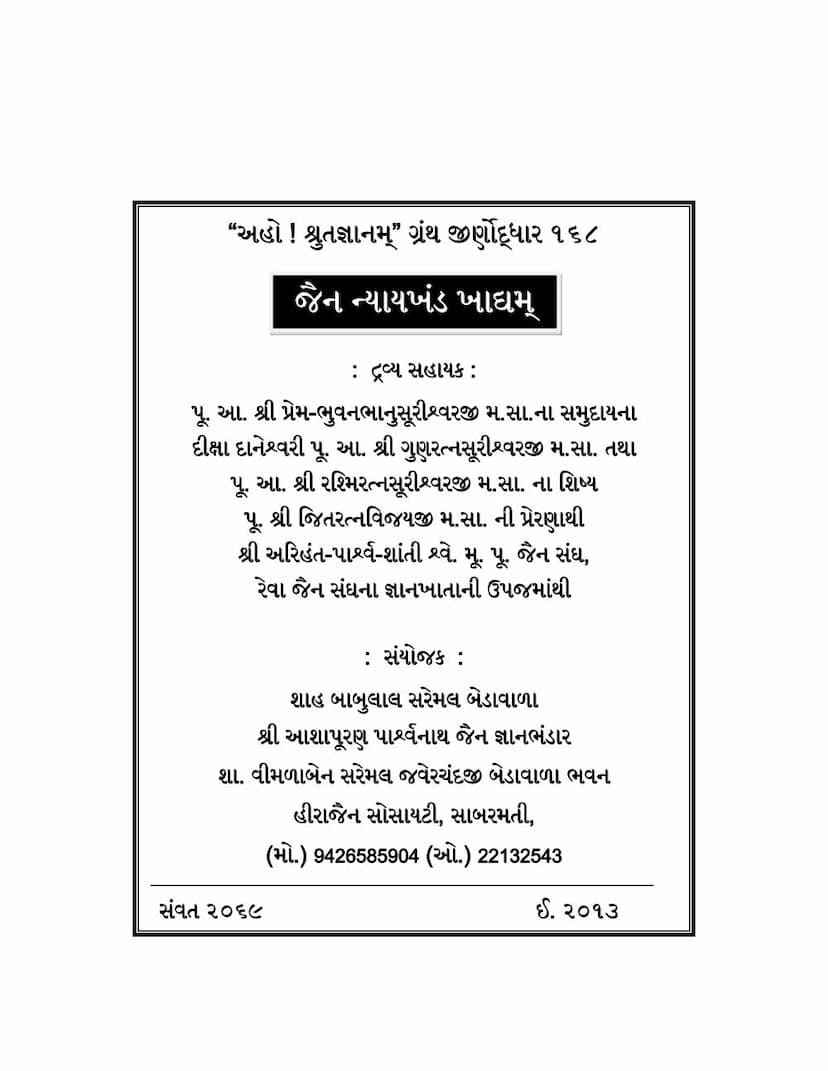Jain Nyaya Khanda Khadyam
Added to library: September 2, 2025

Summary
This is a comprehensive summary of the Jain text "Jain Nyaya Khanda Khadyam" by Yashovijay, edited with a Hindi commentary by Badrinath Shukla, published by Chaukhambha Sanskrit Series Office.
The provided text is a catalog or listing of various Jain and Sanskrit books, with "Jain Nyaya Khanda Khadyam" being one of the prominent entries. The initial pages (1-10) serve as a directory or index of digitized ancient and rare Jain books, many of which are listed with their authors, commentators, languages, and page counts. The project "Aho! Shrutgyanam" is dedicated to preserving and making these texts accessible through DVDs and a website.
The core of the text, starting from Page 11 onwards, is the book itself: "Jain Nyaya Khanda Khadyam" (जैनन्यायखण्डखाद्यम्).
Here's a breakdown of its content based on the provided pages:
Book Details:
- Title: Jain Nyaya Khanda Khadyam (जैनन्यायखण्डखाद्यम्)
- Author: Sri Yasovijaya Suri (श्रीयशोविजयसूरि)
- Commentary (Hindi): Vimasha (विमर्शाख्य हिन्दी व्याख्योपेतम्) by Acharya Sri Badrinath Shukla, M.A., Nyaya-Vedantacharya, Professor at Varanasi Sanskrit University.
- Publisher: Chaukhambha Sanskrit Series Office, Varanasi-1.
- Edition: First Edition, Samvat 2023 (1966 CE).
- Price: 800 (likely Indian Rupees).
Subject Matter and Content:
The text is fundamentally a philosophical and logical treatise within the Jain tradition, specifically focusing on Jain logic (Nyaya). Based on the "Vishay Suchi" (Table of Contents) and the subsequent textual content, the book delves into:
-
Critique of Other Philosophies: A significant portion of the text is dedicated to refuting the logical arguments and philosophical positions of other Indian schools of thought, primarily Buddhism (Baudh) and Nyaya (Naiyayik). The author engages in detailed polemics, analyzing and dismantling their core tenets related to:
- The nature of reality: Examining concepts like impermanence (Kshanbhangavada) and emptiness (Nairatmya) from the Buddhist perspective and contrasting them with Jain principles.
- The nature of the self (Atman): Debating the existence of a permanent, distinct self versus the Buddhist notion of a non-self.
- Causality and Potency (Samarthya): Analyzing the Buddhist concept of potency and its relationship to causality, and the Jain/Nyaya counterarguments.
- The nature of knowledge and reality: Discussing whether reality is solely mental (Vijnanavada) or also external.
-
Jain Logic and Epistemology: The book systematically presents and defends the Jain logical framework, emphasizing:
- Anekantavada (Multi-sidedness): The Jain doctrine that reality possesses infinite aspects and can be viewed from multiple perspectives.
- Syadvada (Conditional Predication): The Jain method of logical predication that acknowledges the conditional nature of truth, using phrases like "syat" (perhaps, in some way).
- Naya (Standpoints): The importance of different logical standpoints (like Dravyanaya, Paryayanaya) in understanding reality.
- Pramanas (Sources of Knowledge): Implicitly or explicitly discussing the validity of Jain means of knowledge.
-
Key Debates and Concepts Discussed:
- Kshanbhanga (Momentariness) vs. Nityata (Eternity): A central debate with Buddhist and Nyaya schools.
- Kurnadrupattva (The quality of being the doer): Discussed in relation to Buddhist causality.
- Gudartha-tattvaloka (Mysterious meaning of reality): Indicating a deep philosophical exploration.
- The nature of the soul (Atman): Examining its permanence, attributes, and relation to the body.
- The concept of "Upadhi" (Accidental quality/condition) and "Jati" (Universal category): Discussed in the context of distinguishing between real essences and superficial attributes.
- The relationship between knowledge (Jnana) and the known (Jneya): A crucial topic in Indian philosophy, with Jain perspectives being presented.
- Theories of causation: Examining different views on how events come about.
- The concept of "Chitra" (Varied, multicolored) in relation to reality and perception: Discussing how the Jain perspective accommodates the multiplicity of aspects in reality.
- The role of "Svadravyata" (own-substance-ness) and "Parajatyabhinna" (not different from other universals): Exploring the interplay between the inherent nature of a thing and its universal characteristics.
- The nature of "Vastu" (Substance) and its "Dharma" (Qualities): Highlighting the Jain view of substances possessing infinite qualities.
- The limitations of other philosophical systems: The text actively criticures the perceived shortcomings and logical fallacies in opposing viewpoints.
-
Structure of the Text: The book is structured as a dialogue or debate, where the author presents arguments, likely from the Buddhist or Nyaya perspective, and then systematically refutes them using Jain logic and reasoning. The extensive commentary by Badrinath Shukla aims to clarify the intricate arguments and provide a deeper understanding of Yashovijaya's thought.
Authoritative Figure:
- Yashovijay (यशोविजय): A highly respected Jain scholar and philosopher, particularly renowned for his contributions to Jain logic and dialectics. His work often involves synthesizing and clarifying Jain philosophical tenets.
- Badrinath Shukla (बदरीनाथ शुक्ल): A prominent scholar of Indian philosophy and Sanskrit, who provided an exhaustive Hindi commentary, making the complex original text accessible to a wider audience.
In essence, "Jain Nyaya Khanda Khadyam" is a rigorous philosophical text that showcases the power and sophistication of Jain logic in engaging with and critiquing other major philosophical traditions. It serves as a testament to the intellectual depth of Jainism and its commitment to dialectical reasoning for the understanding of ultimate reality.